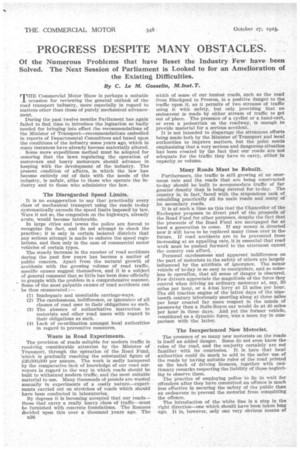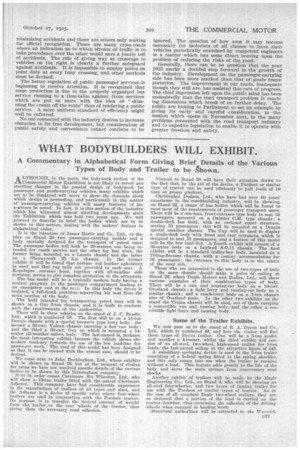PROGRESS DESPITE MANY OBSTACLES.
Page 34

Page 35

If you've noticed an error in this article please click here to report it so we can fix it.
Of the Numerous Problems that have Beset the Industry Few have been Solved. The Next Session of Parliament is Looked to for an Amelioration of the Existing Difficulties.
By C. Le M. Gosselin, M. Inst. T.
TEE Commercial Motor Show is perhaps a suitable occasion for reviewing the general outlook of the road transport industry, more especially in regard to matters other than those of purely mechanical advancement.
During the past twelve months Parliament has again failed to find time to introduce the legisation so badly needed for bringing into effect the recommendations of the Minister of Transport—recommendations embodied in reports of Departmental Committees and based upon the conditions of the industry some years ago, which in many instances have already become materially altered.
Some more expeditious method must be adopted for ensuring that the laws regulating the operation of motorcars and heavy motorcars should advance in keeping with the development of the industry. The present condition of affairs, in which the law has become entirely out of date with the needs of the industry, is unfair, alike to those who operate the industry and to those who administer the law.
The Disregarded Speed Limits.
It is no exaggeration to say that practically every class of mechanical transport using the roads to-day systematically exceeds the speed limits imposed by law. Were it not so, the congestion on the highways, already acute, would become intolerable.
In large cities and towns the police are forced to recognize the fact, and do not attempt to check the practice ; it is only in certain isolated districts that any serious attempt is made to enforce the speed regulations, and then only in the case of commercial motor vehicles of certain types.
The steady increase in the number of road accidents during the past few years has become a matter of public concern. Apart from the natural growth of accidents with the growing volume of road traffic, specific causes suggest themselves, and it is a subject of general comment that so little has been done officially to grapple with the problem in a comprehensive manner. Some of the most palpable causes of road accidents can be thus enumerated (1) Inadequate and unsuitable carriage-ways.
(2) The carelessness, indifference, or ignorance of all classes of road user to their obligations as such.
(3) The absence of authoritative instruction to• motorists and other road users with regard to their obligations as such.
(4) Lack of co-ordination amongst local authorities in regard to preventive measures.
Waste in Road Experiments.
The provision of roads suitable for modern traffic is receiving considerable attention by the Minister of Transport, through the operation of the Road Fund, Which is gradually reaching the substantial figure of i20,000,000 per annum. The work is sadly hampered by the comparative lack of knowledge of our road surveyors in regard to the way in which roads should be built to withstand modern traffic, and the most suitable material to use. Many thousands of pounds are wasted annually in experiments of a costly nature—experiments carried out on stretches of roads which should have been conducted in laboratories.
By degrees it is becoming accepted that our roads— those that carry a really heavy class of traffic—must be furnished with concrete foundations. The Romans decided upon this over a thousand years ago. The
D36 width of some of our busiest roads, such as the road from Blackpool to Preston, is a positive danger to the traffic upon it, as it permits of two streams of traffic using it with safety, but only providing that no endeavour is made by either stream of traffic to get out of place. The presence of a cyclist or a hand-cart, or even a pedestrian on the roadway, is enough to provide material for a serious accident. _
It is not intended to disparage the strenuous efforts being made both by the Minister of Transport and local authorities to improve matters, but the point needs emphasizing that a very serious and dangerous situation has been created by the fact that our roads are not adequate for the traffic they have to carry, either in capacity or volume.
Many Roads Must be Rebuilt.
Furthermore, the traffic is still growing at an enormous rate and the roads that are being constructed to-day should be built to accommodate traffic of far greater density than is being catered for to-day. The country is, in fact, faced with the stupendous task of rebuilding practically all its main roads and many of its secondary roads. It is at such a time as this that the Chancellor of the Exchequer proposes to divert parr of the proqeeds of the Road Fund for other purposes, despite the fact that the proceeds of the Road Fund are mortgaged for at least a generation to come. If any money is diverted now it will have to be replaced many times over in the future. If road accidents are to be prevented from Increasing at an appalling rate, it is essential that road work must be pushed forward to the uttermost extent the country can afford.
Personal carelessness and apparent indifference on the part of motorists to the safety of others are largely influenced by the attribute of ignorance. The motor vehicle of to-day is so easy to manipulate, and so noiseless in operation, that all sense of danger is obscured. Few drivers appreciate the magnitude of-the force they control when driving an ordinary motorcar at, say, 30 miles per hour, or a 4-ton lorry at 15 miles per hour. The old traction engine of the latter. days of the 'nineteenth century laboriously snorting along at three miles per hour created far more respect in the minds of passers-by than a Rolls-Royce car would do at 40 miles per hour in these days. And yet the former vehicle, considered as a dynamic force, was a mere toy in comparison with the latter.
The Inexperienced New Motorist.
The presence of so many new motorists on the roads Is itself an added danger. Some do not even know the rules of the road, and the majority certainly are not familiar with its courtesies. It is here that local authorities could do much to add to the safer use of the roads by having suitable rules of the road printed on the back of driving licences, together with cautionary remarks respecting the liability of those neglecting to observe them.
The practice of employing police to lie in wait for offenders after they have committed an offence is much less effective in securing the safety of the public than an endeavour to prevent the motorist from committing the offence.
The introduction of the white line is a step in the right direction—one which should have been taken long ago. It is, however, only one very obvious means of minimizing accidents and there are others only waiting for official recognition. There are many cross-roads where an indication as to which stream of traffic is to take precedence over the other would save a yearly toll of accidents. The rule of giving way at crossings to vehicles on the right is clearly a further safeguard against accidents. It is impossible to employ police on point duty at every busy crossing, and other methods must be devised.
The better regulation of public passenger services is beginning to receive attention. It is recognized that some protection is due to the properly organized bus service running to a time-table against those services which are put on more with the idea of "skimming the cream off the route" than of rendering a public service. A more uniform standard of efficiency might well be enforced.
No one connected with the industry desires to increase obstacles to its free development, but consideration of public safety and convenience cannot continue to be ignored. The question of how soon it may become necessary for motorists of all classes to have their vehicles periodically examined by competent engineers is a matter which has some direct bearing upon the problem of reducing the risks of the road.
Generally, there can be no question that the year 1925 marks a decided step forward in the growth of the industry. Development on the passenger-carrying side has been more marked than that of goods transportation. The improvement in our roads, inadequate though they still are, has assisted this rate of progress. The chief impression left upon the public mind has been undoubtedly that the road transport problem is reaching dimensions which brook of no furtherdelay. The public are looking to Parliament to set an example by giving its early and careful consideration, in the session which opens in November next, to the many problems connected with the road transport industry and to expedite legislation to enable it to operate with greater freedom and safety.




























































